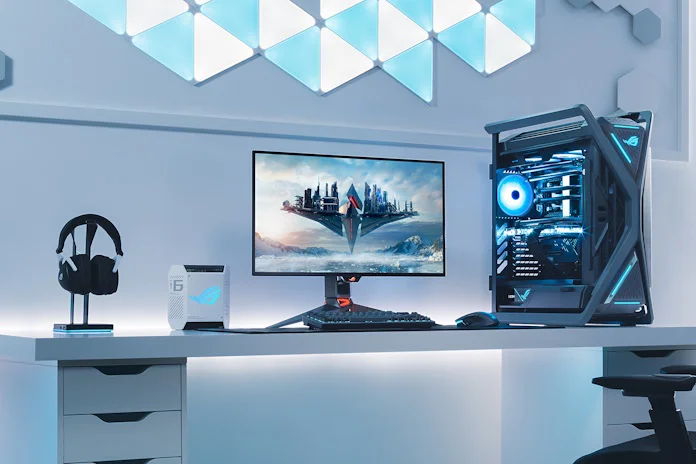2023 is a fantastic time to buy a gaming monitor. Enthusiasts craving next-gen tech can find new gaming-changing display technologies on the market. Mainstream gamers looking for a high-impact upgrade to their PC have their pick from a wide range of fully featured options. Even gamers on a budget are spoiled with more options than ever before that deliver incredible bang for the buck. No matter what kind of a gamer you are, there’s an ROG or TUF Gaming display ready to take your gaming experiences to the next level.
If you’ve been holding off on a monitor upgrade, biding your time as you get a little more mileage out of a years-old display, your wait is over. Prices are great, sales abound, and the payoff for upgrading to a modern monitor has never been greater.
Perhaps it’s been a few years since you last checked in on the display market. In this guide, we’ll catch you up to speed. First, we’ll give you a cheat sheet on the key technologies that matter most to gamers. Then, we’ll help connect you with display options from our ROG and TUF Gaming laptops that best fit your preferred games and style of play.
- The display specs that matter most to gamers
- Pick your panel
- The best OLED gaming monitor
- The best monitor for esports gamers
- The best monitor for hardcore gamers
- The best monitor for cross-platform gamers
- The best portable gaming monitors
- The best monitor for mainstream gamers
The display specs that matter most to gamers
It’s important to note right at the start that few PC parts vary in capabilities and price quite so much as monitors do. You can find a simple 1080p 60Hz display for $100 or less, but cutting-edge HDR reference displays for professional content creation might command 30 times that amount or more. As a gamer, you need to get to know the features that matter most for you so that you can effectively compare your options.
Resolution and size
A display’s resolution tells you how many individual pixels it has. Monitors with the same resolution are sold in many different sizes, so make sure to pick the one with the right pixels-per-inch (PPI) for your gaming setup. A monitor that looks great when you’re 10 feet away on your couch might look pixelated or even fuzzy when you’re sitting up close.
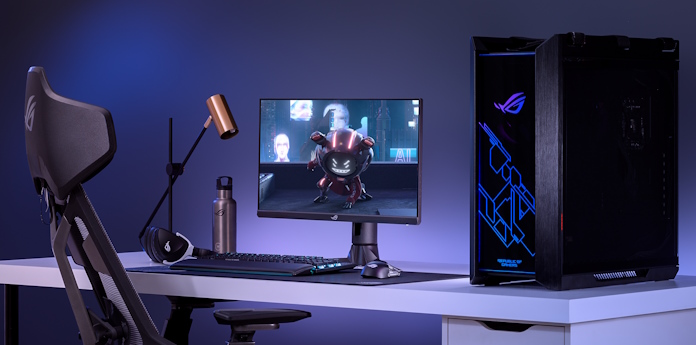
FHD was the standard resolution for many years, offering users a 1920×1080 array of pixels. If your rig has a modern graphics card, your games can run at very high refresh rates at an FHD resolution. 24” FHD monitors let you sit close to your display with decent image clarity. Larger FHD options are available, but generally speaking if you’re looking for an extra-large helping of pixels we’ll point you toward a higher-resolution option.
With their 2560×1440 resolution, 1440p (sometimes called QHD) displays give you a more detailed image than FHD displays and let you bump up to a 27” monitor while maintaining excellent PPI. Many people think that a 1440p monitor with a high refresh rate is the perfect choice for mainstream gamers. It takes a PC with a bit more graphics horsepower to game at this higher resolution, but modern mainstream graphics card options are more than up to the challenge.
Monitors with a 4K, or 3840×2160 resolution, offer a premium gaming experience with exceptionally detailed images. With displays sizes up to 48 inches, 4K monitors are perfect for anyone who desires a large window into gaming worlds — or anyone who prefers exceptionally high pixel densities. Playing the latest AAA games with Ultra settings at a 4K resolution can require a potent PC, so pair your 4K display with a cutting-edge graphics card for the best experience.
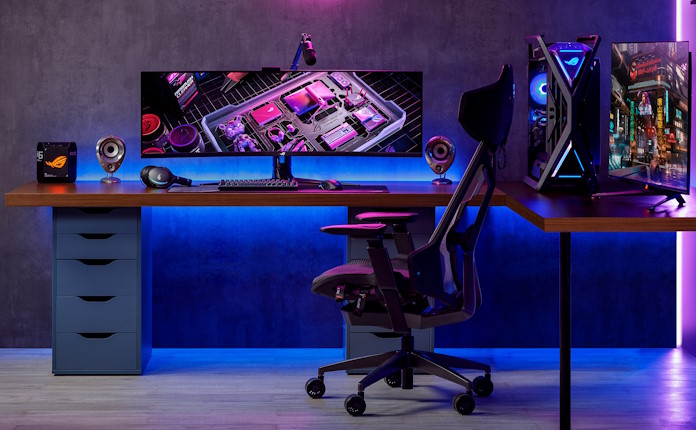
Finally, you might be interested in an ultrawide display. These monitors provide extra horizontal screen space for heightened immersion in your favorite games. As with the more-common 16:9 aspect ratio, there are a wide array of options. A 21:9 aspect ratio monitor gives you a wider window into your games, usually with a 3440×1440 or 2560×1080 resolution. 32:9 super-ultrawide displays give you the same experience as having two 16:9 monitors sitting side by side — but in one seamless display. These models are especially popular among racing and flight sim enthusiasts, but don’t discount how much they add to your experience in first-person shooters, as well.
Refresh rate
Your monitor’s refresh rate indicates how fast it can refresh the content on the screen. Standard office displays start at 60Hz, but gamers typically pursue monitors with ever-faster refresh rates. The higher the refresh rate, the more fluid and smooth on-screen motion can look, and the more responsive your system can “feel” to keyboard and mouse input, especially in competitive games.
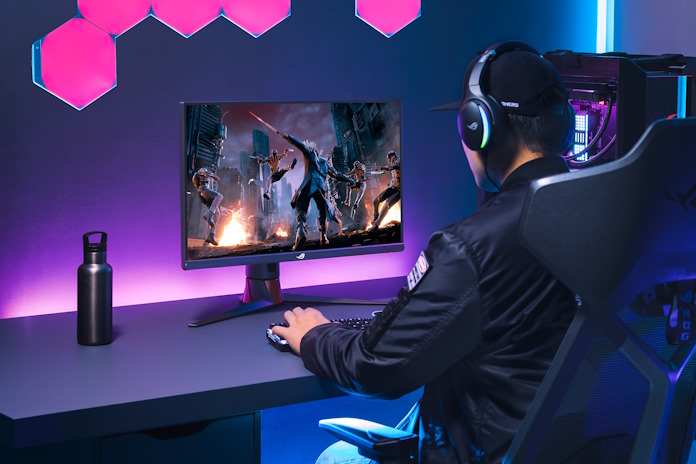
120Hz and 144Hz displays deliver fluid gaming experiences in single-player and story-driven titles. You’ll find many affordable gaming monitors with refresh rates in this range, so we think that any gamer buying a display in 2023 should target at least 120Hz for their next model, even if you’re shopping on a tight budget.
If you like to compete in online esports games, look for options with at least a 240Hz refresh rate to give yourself a commanding view of the battlefield. When milliseconds separate the winners from the hopefuls, it’s invaluable to have a display that can help you more quickly spot an enemy peeking around a corner. Our cutting-edge ROG Swift monitors let you take advantage of even higher refresh rates. Premium 360Hz and even 540Hz options give professional gamers the competitive edge they need for tournament play.
Response time
Response time measures how quickly a pixel can transition from one color to another. It is usually measured using a transition from one shade of gray to another, or the gray-to-gray response time. This figure is usually specified in milliseconds, and lower response times mean crisper, less blurry on-screen motion.
A response time of 3ms or better is a good starting point for gamers, but monitors with 1ms response time will keep fast-paced motion very clear. If premium image clarity in fast-paced content is a priority for you, check out our lineup of OLED monitors. These displays can each response times of less than 0.2ms.
Color performance and HDR
For the most vivid, lifelike visuals in your favorite games, purchase a monitor with wide color gamut coverage. Regardless of panel type, better displays can show more colors than basic monitors, and this performance is quantified in reference to a standard color gamut, or a certain subset of all of the visible colors. The most commonly used color gamut is known as sRGB. Monitors that claim 100% sRGB coverage will look great with most types of content and games available today. Displays with wide color gamuts, such as DCI-P3 and Adobe RGB, can reproduce more saturated or vivid colors than monitors that only support sRGB.

DCI-P3 support is especially relevant for high dynamic range (HDR) monitors. These screens can display a much wider range of brightness levels from dark to light, resulting in more lifelike images and potentially stunning effects for content like flashes from explosions or the sun peeking out from behind a mountain.
HDR support is commonly certified independently by the standards body VESA, whose DisplayHDR program sets a range of performance standards for HDR monitors, including those from ASUS. For the best possible experience, look for a model with a VESA DisplayHDR 1000 certification, but you’ll also get a great HDR experience from DisplayHDR 600 models. ROG OLED monitors deliver exceptional color gamut coverage with professional-grade accuracy for astonishing HDR performance.
Color accuracy
Color accuracy tends to matter more for content creators than gamers, but it’s worth noting that some monitors are better than others at accurately representing colors, as compared to their theoretical representation within a color gamut. Displays whose color accuracy is measured will usually have a rated specification known as average Delta E, and creative users who need to have their work appear consistent across different displays desire an average Delta E of less than 2.
ASUS ProArt displays are factory-calibrated to ensure a low average Delta E, so creative users can trust their work to these monitors right out of the box. Some ROG gaming monitors are also factory calibrated so that gamers can experience digital worlds exactly as their developers intended.
VRR support
Almost all modern gaming monitors also support variable refresh rates, meaning that they can refresh what’s on screen right as the graphics card produces a new frame rather than simply refreshing a fixed number of times per second. If a monitor claims support for NVIDIA G-SYNC or G-SYNC Compatible, AMD FreeSync, or Adaptive Sync, it supports variable refresh rates.
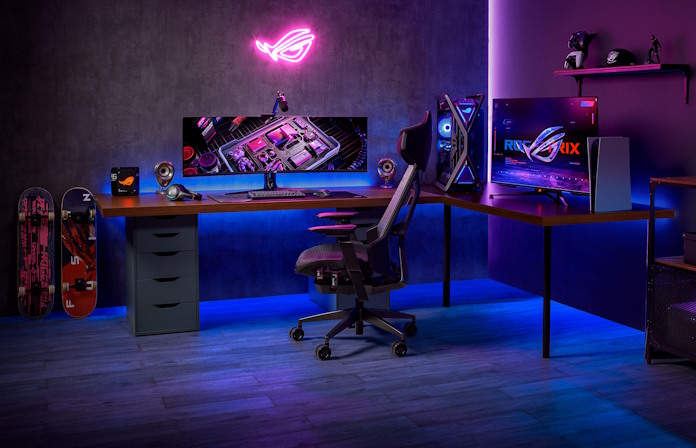
Monitors with variable refresh rates avoid an undesirable image artifact called tearing, where parts of multiple frames are visible on screen at once. They do this across a refresh rate range, such as 48Hz to 144Hz. So long as the GPU’s delivered frame rate is within its refresh rate range, a variable refresh rate monitor can cleanly draw each new frame as soon as it’s ready. This technique makes games look “smoother” and can make them feel more responsive to your input.
Variable refresh rate support should absolutely be on your checklist for your next monitor. The question in 2023 is what tier of G-SYNC or FreeSync you’d prefer. For example, NVIDIA has a laundry list of display specifications for any display with a G-SYNC Ultimate certification, so it’s a great way for ensuring that you’ll get a cutting-edge experience from your display without having to dig too far into the nitty-gritty details.
Connection type
Modern graphics cards offer DisplayPort and HDMI ports to connect to your display, and your new gaming monitor will connect to either of those port types without a fuss. Mainstream PC gamers with FHD or QHD displays are best served with DisplayPort connections, as that connection type has the bandwidth to support very fast refresh rates.
Consoles, on the other hand, rely on HDMI ports. If you intend to connect your display to both your gaming PC and a next-gen console, look for a monitor with an HDMI 2.1 port ready for the best combination of refresh rate and resolution your console can provide.
It’s also worth considering the other devices that you might want to connect to your monitor. A display with a USB passthrough, for example, can reduce the clutter on your desk by allowing you to connect one or more peripherals to a handy USB port on your display rather than to your desktop.
Pick your panel
Now that you’re armed with this information about display tech, you can make a choice about what kind of panel technology best fits your needs as a gamer.

Twisted nematic, or TN, panels, are generally found in entry-level displays where low cost is most important. Until recently, TN panels had the lowest response times and fastest refresh rates of any panel technology, making them favorites among competitive gamers. While they tend to be kinder to your wallet, displays with TN panels can have narrower viewing angles and potentially less vivid color reproduction than other panel technologies.
Vertical alignment, or VA, panels, are noted for their exceptionally strong contrast ratios, generally fast response times, and vivid color reproduction. VA panels have wider viewing angles than TN panels but may still trail IPS LCDs in this regard.
In-plane switching, or IPS, displays can offer an attractive balance of performance characteristics: wide viewing angles, vivid and accurate color reproduction, and solid contrast ratios. Because of these balanced performance characteristics, IPS panels have become one of the most popular LCD panel technologies in use. IPS panels are available in monitors of all types, from basic productivity displays to high-refresh-rate gaming monitors to professional displays for color-critical work. For gaming, the latest ASUS Fast IPS panels now offer response times similar to those of TN panels without any compromises in viewing angles or color reproduction.
For gamers who dare to want it all, premium organic light-emitting diode, or OLED, panels beckon with an astonishing set of display characteristics. Unlike TN, VA, and IPS panels, which rely on backlighting, each pixel in an OLED panel is its own light source. That allows these displays to deliver astonishing contrast with inky blacks and bright highlights. What’s more, they feature the lowest response times of any panel type alongside that vivid color reproduction. Now that you can get an OLED display with a 240Hz refresh rate, it’s clear that this is the panel technology of choice for enthusiasts.
The best monitors for any gamer
With all these display specifications in mind, let’s get down to some specific recommendations. Here, we’ll boil things down to specific categories so that you can find the best ROG or TUF Gaming monitor for your gaming setup.
The best OLED gaming monitor
Boasting exceptional contrast, response times, color performance, monitors with an OLED panel are your premium pick for gaming in 2023. ROG ups the ante with a custom heatsink that provides more efficient cooling performance, even in long gaming sessions. The lower temperature enables better OLED performance with lower likelihood of image sticking. As an added boon, it operates silently to minimize distractions thanks to an entirely fanless cooling system.
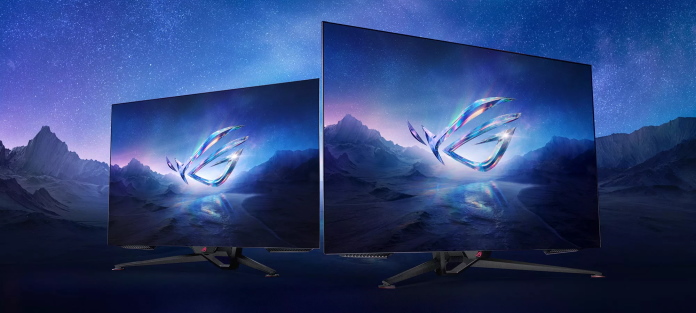
When activated, the ROG-exclusive Uniform Brightness setting within the OSD menu decreases peak brightness to keep levels consistent for better viewing, even when changing the size of bright white windows. It also makes marathon gaming sessions much more comfortable on the eyes.
For OLED gaming, we offer three options from our ROG lineup, starting with the ROG Swift OLED PG27AQDM. This 27-inch display fits comfortably on any desk, and it offers a compelling balance of detail and fluid animation with its 1440p panel and 240Hz refresh rate. For anyone who loves fast-paced action and competitive esports, this might be the perfect monitor.
Prefer to kick back with a large display? Check out the ROG Swift OLED PG42UQ and ROG Swift OLED PG48UQ. At 41.5 inches and 47.5 inches, respectively, these monitors lavish your eyes with an immersive sweep of pixels. Their refresh rates aren’t quite as high as the ROG Swift OLED PG27AQDM, but in return they offer a detailed 4K resolution.
| Model | Size | Resolution | Refresh Rate | Availability (U.S.) | Availability (CA) |
|---|---|---|---|---|---|
| ROG Swift OLED PG27AQDM | 27" | 1440p | 240Hz | ASUS | Best Buy |
| ROG Swift OLED PG42UQ | 41.5" | 4K | 138Hz | ASUS | ASUS |
| ROG Swift OLED PG48UQ | 47.5" | 4K | 138Hz | ASUS | ASUS |
The best monitor for esports gamers
If you’re a competitive gamer, you need a PC and a display that are as fast as your reflexes. Typically, esports gamers build a PC that excels at producing exceptionally high frame rates at a GPU-friendly resolution like FHD. Then, they’ll pair that PC with a monitor with as high a refresh rate as their budget allows.
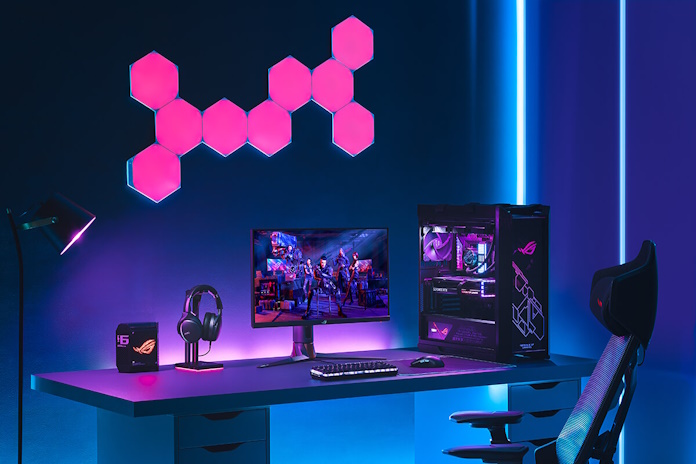
The TUF Gaming VG259QM display gives esports gamers all the essentials at a great price. Boasting a refresh rate that you can overclock up to 280Hz and a low 1ms response time (GTG), this Fast IPS display is ready to kickstart your competitive ambitions.
ROG kicks things up a notch with the ROG Swift 360Hz PG27AQN. This display not only dials up the refresh rate to a sizzling 360Hz, it offers NVIDIA Reflex Analyzer to help keep latency low and responsiveness high across a wider range of frame rates. For gamers who desire a balance of detail and speed, it combines its dazzling refresh rate with a 1440p resolution.
Soon, we’ll redefine tournament-level display performance with the ROG Swift 540Hz PG248QP. Boasting an unheard-of 540Hz refresh rate, this display will set new standards for fluid, responsive animation in fast-paced games.
| Model | Size | Resolution | Refresh Rate | Availability (U.S.) | Availability (CA) |
|---|---|---|---|---|---|
| TUF Gaming VG259QM | 24.5" | FHD | 280Hz (OC) | ASUS | Amazon |
| ROG Swift PG279QM | 27" | 1440p | 240Hz | ASUS | Amazon |
| ROG Swift 360Hz PG27AQN | 27" | 1440p | 360Hz | ASUS | ASUS |
The best monitor for hardcore gamers
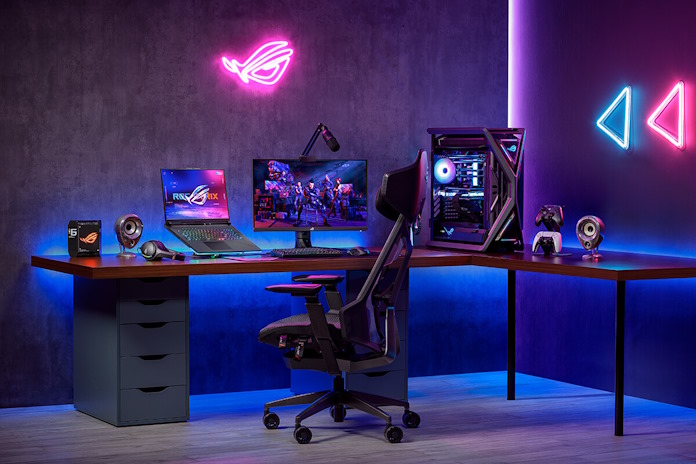
Experienced gamers often know exactly what cutting-edge feature they’re looking for in their next monitor — and they know that ROG’s premium options deliver what they need. For gamers chasing the best HDR experiences available today, we offer the ROG Swift PG32UQX. With its top-tier VESA DisplayHDR 1400 certification, it produces astonishingly detailed highlights with its local-dimming Mini LED backlight.
For ultimate immersion, many gamers seek out extra-wide displays that wrap around the periphery of their vision. The ROG Strix XG49WCR will enfold you in a super-ultrawide 49-inch display — it’s like two 1440p displays connected seamlessly in one monitor. With Smart KVM, you can even use it to control two connected devices using just one keyboard and mouse. Check out its spec list, and you’ll see that it doesn’t compromise on its way to immersive gaming experiences: with its 165Hz refresh rated, ELMB Sync support, wide connectivity including USB Type-C, and 90% DCI-P3 coverage, it offers premium features from top to bottom.
| Model | Size | Resolution | Refresh Rate | Availability (U.S.) | Availability (CA) |
|---|---|---|---|---|---|
| ROG Swift PG32UQX | 32" | 4K | 144Hz | ASUS | |
| ROG Strix XG49WCR | 49" | 5120x1440 | 165Hz (OC) | ASUS |
The best monitor for cross-platform gamers
Many gamers today aren’t locked into one platform. You might very well have certain games that you love to play on your gaming PC, and others that you prefer to play on your Xbox, PlayStation, or Nintendo Switch. Pick the right monitor, and you can game in front of one screen without compromising on quality, no matter what system you’re using. Maybe you even have an ROG Ally, the ultimate handheld PC gaming device, but want to plug it in at home to a larger format display for some multiplayer fun.

The key spec you’re looking for as a cross-platform gamer is an HDMI 2.1 port. This protocol unlocks higher data rates over the HDMI cable, enabling higher resolutions, higher 120Hz refresh rates at existing resolutions, and a number of desirable features like automatic low-latency mode and variable refresh rates for gaming devices.
In the table below, you’ll find a compelling list of options with an HDMI 2.1 port. Since you’ll likely be kicking back with a controller as a cross-platform gamer, we’re recommending some of our larger options, starting with the 32-inch ROG Strix XG32UQ and ranging all the way up to the massive ROG Swift OLED PG48UQ. In the middle is the exceptionally well-balanced ROG Swift XG43UQ Xbox Edition, which we fine-tuned for a premium experience with your Xbox Series X. If these displays are a bit too large for your gaming setup, look no further than the TUF Gaming VG28UQL1A. Armed with HDMI 2.1 support, a 4K resolution, and a fluid 144Hz refresh rate, it offers everything you need for your cross-platform gaming setup.
| Model | Size | Resolution | Refresh Rate | Availability (U.S.) | Availability (CA) |
|---|---|---|---|---|---|
| TUF Gaming VG28UQL1A | 28" | 4K | 144Hz | ASUS | Newegg |
| ROG Strix XG32UQ | 32" | 4K | 160Hz (OC) | ASUS | ASUS |
| ROG Swift PG38UQ | 38" | 4K | 144Hz | ASUS | |
| ROG Swift XG43UQ Xbox Edition | 43" | 4K | 144Hz | ASUS | |
| ROG Swift OLED PG48UQ | 47.5" | 4K | 138Hz (OC) | ASUS | ASUS |
The best portable gaming monitors
Some folks primarily play games at their desk. Others play games almost exclusively from the couch in their living room. But many people today want to game no matter where life takes them. To empower your portable gaming ambitions, set yourself up with a portable gaming monitor. Our portable monitors travel easily due to their thin, lightweight design. Anywhere you go, you’ll be able to connect your smartphone, portable gaming console, or laptop to your portable monitor and enjoy a larger, more immersive display.
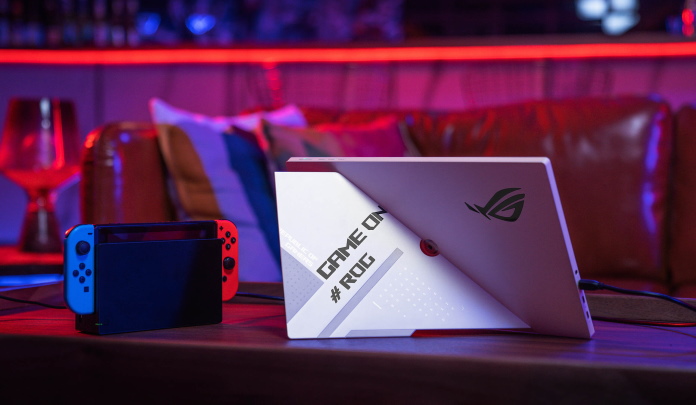
Our ROG Strix portable gaming monitor lineup gives you the gaming features you need in a design that travels. Their low 3ms response time (GTG) provide clear images in fast-paced action games, and their fast refresh rates — up to 240Hz — give you lightning-quick animation. All our ROG Strix portable gaming monitors have a built-in battery and Adaptive Sync tech. Grab an ROG Strix XG17AHP or XG16AHP-W to get a foldable ROG Tripod that makes it easy to set up anywhere.
Not all portable gaming devices let you take full advantage of a high-refresh-rate display. If you primarily game on the go to a device that’s capped to 30 or 60 FPS, you might be best served with a portable monitor with an ultra-low response time, exceptional contrast, and vibrant colors. The ZenScreen OLED MQ16AH delivers all three in droves. Its OLED panel provides colors that pop, blur-free animation, and HDR support, making it a premium pick for connecting to a device like a Nintendo Switch.
| Model | Size | Resolution | Refresh Rate | Availability (U.S.) | Availability (CA) |
|---|---|---|---|---|---|
| ROG Strix XG16AHPE | 15.6" | FHD | 144Hz | ASUS Amazon | Amazon |
| ROG Strix XG16AHP-W | 15.6" | FHD | 144Hz | ASUS Amazon | Amazon |
| ROG Strix XG17AHPE | 17.3" | FHD | 240Hz | ASUS Amazon Newegg B&H | Best Buy Newegg |
| ROG Strix XG17AHP | 17.3" | FHD | 240Hz | ASUS Amazon B&H | |
| ZenScreen OLED MQ16AH | 15.6" | FHD | 60Hz | ASUS Best Buy B&H | ASUS Amazon Best Buy |
The best monitor for mainstream gamers
We’ll wrap up this list with some recommendations for gamers on a tighter budget. If it’s been a little while since you last shopped for a gaming monitor, you might be pleasantly surprised by everything that these options offer.
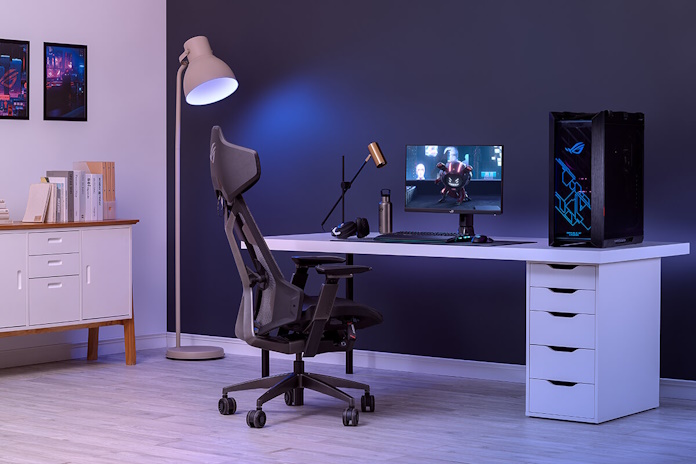
Even our entry-level options from ROG and TUF Gaming offer variable refresh rate tech, fluid refresh rates, and low response times — all essential gaming features in 2023, and all available at affordable prices. Check out the TUF Gaming VG248QG for a gaming-ready 24-inch display with a standard FHD resolution, and don’t miss how the TUF Gaming VG27AQA1A makes 27-inch 1440p gaming affordable for just about everyone.
| Model | Size | Resolution | Refresh Rate | Availability (U.S.) | Availability (CA) |
|---|---|---|---|---|---|
| TUF Gaming VG248QG | 24" | FHD | 165Hz (OC) | ASUS | ASUS |
| TUF Gaming VG24VQE | 23.6" | FHD | 165Hz (OC) | ASUS | ASUS |
| TUF Gaming VG278QR | 27" | FHD | 165Hz (OC) | ASUS | ASUS |
| TUF Gaming VG27VH1B | 27" | FHD | 165Hz (OC) | ASUS | Newegg |
| TUF Gaming VG27AQA1A | 27" | 1440p | 170Hz (OC) | ASUS | |
| TUF Gaming VG30VQL1A | 29.5" | 2560x1080 | 200Hz (OC) | ASUS | ASUS |
| TUF Gaming VG328H1B | 31.5" | FHD | 165Hz (OC) | ASUS | ASUS |
| TUF Gaming VG32AQA1A | 31.5" | 1440p | 170Hz (OC) | ASUS | ASUS |

